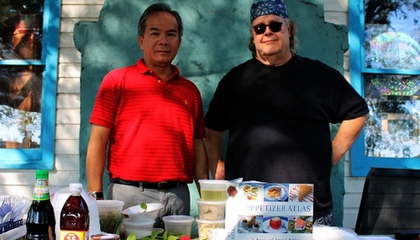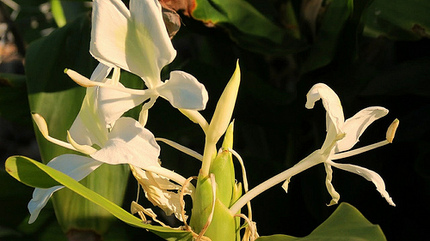On Sunday afternoon we’re hosting a Thai cooking event with Sap
and Mick. It’s always very exciting to have these experts at the
nursery, and I thought it would be useful to write about some of the
herbs that are essential to successful Thai cooking. You can grow all
of these very easily.
______________________________________________________
Thai Lime (Citrus hytrix)
This is a lime tree that can be grown from cuttings or seed. The lime
is rough and bitter and the tree is quite thorny. But it is the leaves that
are used in abundance in Thai recipes. The zest of the fruit is also
used in making curry pastes. Like most citrus, Thai lime (known as
Mak-root in Thailand) should be given a full sun to part shade expo-
sure. Since most citrus isn’t cold hardy, Thai lime should be grown
in a container, so it can be protected in the winter. They are consi-
dered heavy feeders and should be given frequent applications of
plant food, especially during the growing season (spring to fall). If
you have ever wanted to grow citrus, this is a good place to start.
______________________________________________________
Lemon Grass (Cymbopogon citrates)
This is a clump grass that is easy to grow and is used heavily in many
Thai recipes. It can grow to a height of 4 feet and loves a sunny expo-
sure. Lemon grass likes a deep soil, rich in compost, and a protected
spot away from the winter wind. After the first frost you should cut
it back and mulch it heavily. The fleshy part base of each stalk is used
for cooking. It should be minced finely and then ground in a food
processor. Lemon grass is used to make curries, soups, and teas.
______________________________________________________
Galangal Ginger (Alpinia galangal)
An exotic ginger with greenish-blue leaves and the most beautiful
white flowers. It grows 4 to 5 feet in height and spreads via under-
ground roots or rhizomes. Galangal ginger, or kha as it is known in
Thailand, flourishes in the shade and requires some winter protec-
tion. If it is planted outside, it should be placed in a protected spot
and mulched heavily for winter. It also does well as an indoor plant.
Grown indoors, it should be given a sunny spot close to a window.
The fleshy rhizome of this plant can be harvested for use in soups
such as tom-khaa, and in stews.
______________________________________________________
Thai sweet basil (Ocimum basilicum var thyrsiflora)
Called horapa in Thai, this is an easy-to-grow summer annual herb
related to sweet basil. It has a paler green leaf with purplish color-
ation close to the flower bracts. Like all basils, it enjoys a sunny
exposure and moist, well-drained soil. Basil always dies away after
the first bout of cold weather. However it can be grown in a sunny
kitchen window or garden room. One can also save the seed for next
spring’s planting. Thai sweet basil is used as a garnish for its aromatic
qualities.
______________________________________________________
Holy Basil (Ocimum tenuiflorum)
This is also very easy to grow in the spring through fall garden. Its
leaves and flower bracts are purplish in color, adding a striking orna-
mental effect to the garden. Holy basil is always cooked before eating.
It is used for stir-fry and has a very aromatic, peppery flavor.
Happy gardening everyone!





 Visit the website: www.itsaboutthyme.com
Visit the website: www.itsaboutthyme.com